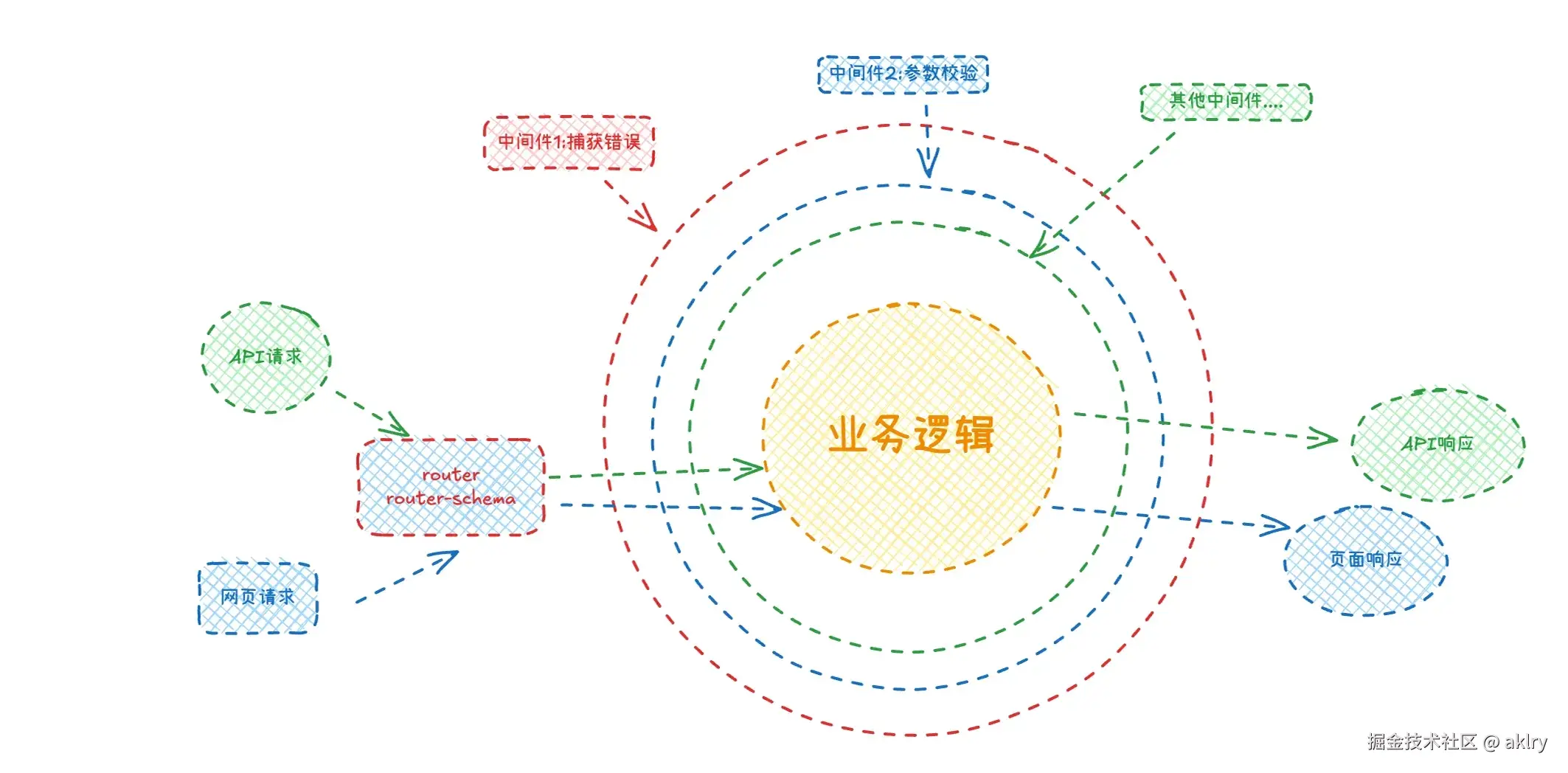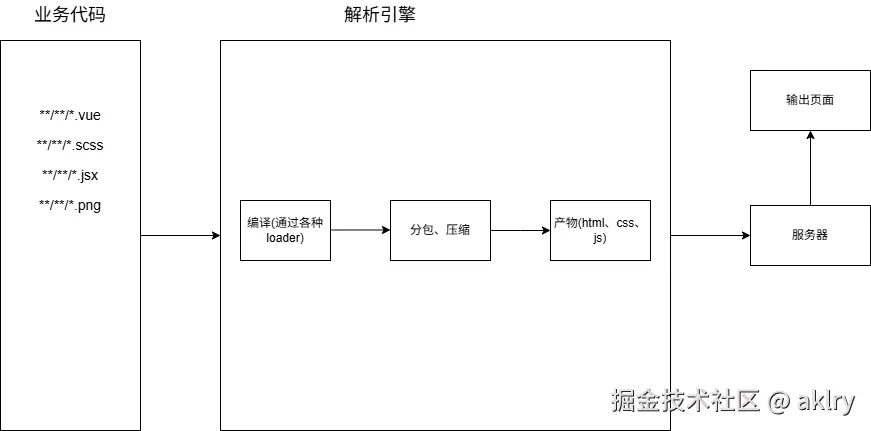elpis之学习总结
为什么需要elpis
在日常开发中,随着客户的需求越来越多,我们不得不陷入重复的crud 工作,拿着已经封装好的组件cv之后修修补补又是一个新的组件。这就是绝大多数前端开发者所遇到的困境。为了解决这个问题,elpis 应运而生。elpis能够解决什么问题呢?
- 沉淀80%的重复工作(支持配置化),提供20%的定制开发
- 支持多个入口,一个入口即一个平台
- 系统间功能重复使用
- 支持SSR
- 全栈开发,引入BFF、devops等流程
elpis-core
elpis-core 是elpis框架服务端的启动引擎 ,它利用koa 作为底层,通过loader 的方式结合约定式目录 将每一个目录中的文件都转换为一个对象挂载到koa实例。如图所示:

elpis-core的运行时
elpis-core的运行时是一个洋葱圈模型,如图所示:

工程化
随着前端项目越发庞大,Vue 和React等工具应运而生,但是浏览器只认识HTML、CSS、JavaScript。那怎么办呢?我们就需要一种工程化工具将浏览器不认识的文件如.vue、.jsx文件等转换成浏览器认识的JavaScript(这类工具可以是webpack、vite、rollup等等等等)。

如图,工程化工具在以上流程当中充当的就是解析引擎的角色。
热更新原理
在开发环境中,不仅需要走完解析引擎编译、打包、压缩这一系列流程之外,为了能够实时感知到代码变化后页面的变化,我们需要引入一个服务器,这个服务器需要具备以下两个能力:
- 监听能力 -> 能够实时监听到文件的变化
- 通知能力 -> 在监听到文件变化后通知浏览器刷新页面
除此以外,与生产环境不同的是,开发环境最终只会产出模版文件(比如.tpl文件),剩余的资源文件(如js、css)将会以内存的方式存在于服务器当中,这种方式的好处是节省将文件写入时间,提高开发效率。
性能优化
- 构建方面
- 利用
happypack或thread-loader多线程打包,提升构建速度 - 使用
loader解析对应文件时排除掉非必要依赖(node_modules) - 利用缓存提升构建速度
- 代码方面
- 利用
mini-css-extract-plugin插件将css单独抽离 - 利用
terser-webpack-plugin插件对代码进行压缩 - 利用
optimization.splitChunks对代码进行分包,将长期不变的node_modules单独分包 - 利用
tree-shaking树摇摇掉未使用的代码依赖
领域模型
什么是领域模型
领域模型 又称dsl ,是一份通用的基础配置,通过领域模型,我们可以以其为基础,派生出很多份配置,以面向对象 的角度来谈,领域模型就是一个基类 ,通过这个基类,我们可以利用继承 的思想派生出无数个子类。比如在电商领域,我们可以定义一个基类,然后通过继承便可以派生出诸如淘宝 、拼多多 、抖音电商等站点。
领域模型的定义
利用json-schema的定义规范对字段进行描述,如下:
js
export default {
// 模板类型,不同模板类型对应不一样的模板数据结构
mode: 'dashboard',
name: '', // 名称
desc: '', // 描述
icon: '', // 图标
homePage: '', //首页(项目配置)
// 头部菜单
menu: [
{
key: '', // 菜单唯一描述
name: '', // 菜单名称
menuType: '', // 枚举值, group / module
// 当menuType = group 时, 可填
subMenu: [
{
// 可以递归menuItem
}
],
// 当menuType = module 时, 可填
moduleType: '', // 枚举值 schema/custom/iframe/sider
// 当moduleType = schema 时, 可填
schemaConfig: {
api: '', // 数据源api 遵循RESTful规范
// 板块数据结构
schema: {
type: 'object',
properties: {
key: {
...schema, // 标准schema 配置
type: '', // 字段类型
label: '', // 字段中文名
// 字段在table中的相关配置
tableOption: {
...elTableColumnConfig, //标准el-table-column 配置
visible: true, // 默认为true(false 表示不在表单显示)
toFixed: 2 // 保留小数点后几位
},
// 字段在search-bar中的相关配置
searchOption: {
...elComponentConfig, //标准el-component(form 表单组件) 配置
comType: '', // 配置控件类型(input/select)
default: '', // 默认值
// 当comType = select 时, 可填
enumList: [],
// 当comType = dynamicSelect 时, 可填
api: '' // 枚举列表数据源api 遵循RESTful规范
}
}
}
},
// table相关配置
tableConfig: {
headerButtons: [
{
label: '', // 按钮中文名
eventKey: '', // 按钮事件名
eventOption: {}, // 按钮具体配置
...elButtonConfig // 标准el-button配置
}
],
rowButtons: [
{
label: '', // 按钮中文名
eventKey: '', // 按钮事件名
eventOption: {
// 当eventKey = remove 时, 可填
params: {
// paramKey = 参数的键值
// rowValueKey = 参数值 ,格式为 schema::xxx时,到table中找响应的字段
paramKey: rowValueKey
}
}, // 按钮事件具体配置
...elButtonConfig // 标准el-button配置
}
]
},
searchConfig: {}, // search-bar相关配置
components: {} // 模块组件相关配置
},
// 当moduleType = custom 时, 可填
customConfig: {
path: '' // 自定义路径
},
// 当moduleType = iframe 时, 可填
iframeConfig: {
path: '' // iframe路径
},
// 当moduleType = sider 时, 可填
siderConfig: {
menu: [
{
// 可递归 menuItem(除moduleType = sider)
}
]
}
}
]
}动态组件
动态组件的实现思路

配置设计
json
{
"schemaConfig": {
"schema": {
"type": "",
"properties": {
"key": {
"createFormOption": {
"comType": ""
},
"editFormOption": {
"comType": ""
},
"detailPanelOption": {
"comType": ""
}
}
}
}
},
"componentConfig": {
"createForm": {
"title": "",
"saveText": ""
},
"editForm": {
"title": "",
"saveText": ""
},
"detailPanel": {
"mainKey": "",
"title": ""
}
}
}配置解析
js
import { ref, watch, onMounted, nextTick } from 'vue'
import { useRoute } from 'vue-router'
import { useMenuStore } from '$elpisStore/menu'
export const useSchema = () => {
const route = useRoute()
const menuStore = useMenuStore()
const api = ref('')
const tableSchema = ref({})
const tableConfig = ref()
const searchConfig = ref()
const searchSchema = ref({})
const components = ref({})
// 通用构建方法(清除噪音)
const buildDtoSchema = (_schema, comName) => {
if (!_schema?.properties) return
const dtoSchema = {
type: 'object',
properties: {}
}
// 提取有效 schema 字段信息
for (const key in _schema.properties) {
const props = _schema.properties[key]
const option = props[`${comName}Option`]
if (option) {
let dtoProps = {}
// 提取props中非 option 的部分, 存放到dtoProps
for (const pKey in props) {
if (pKey.indexOf('Option') < 0) {
dtoProps[pKey] = props[pKey]
}
}
// 处理 comName Option
dtoProps = Object.assign({}, dtoProps, { option })
// 处理 required
const { required } = _schema
const isRequired = required && required.find(pKey => pKey === key)
if (isRequired) {
dtoProps.option.required = true
}
dtoSchema.properties[key] = dtoProps
}
}
return dtoSchema
}
// 构造schemaConfig 相关配置,传输给schemaView
const buildData = () => {
const { key, sider_key: siderKey } = route.query
const mItem = menuStore.findMenuItem({
key: 'key',
value: siderKey ?? key
})
if (mItem && mItem.schemaConfig) {
const { schemaConfig: sConfig } = mItem
const configSchema = JSON.parse(JSON.stringify(sConfig.schema))
api.value = sConfig.api ?? ''
tableSchema.value = {}
tableConfig.value = undefined
searchConfig.value = undefined
searchSchema.value = {}
components.value = {}
nextTick(() => {
// 构建tableSchema 和 tableConfig
tableSchema.value = buildDtoSchema(configSchema, 'table')
tableConfig.value = sConfig.tableConfig
// 构建searchConfig 和 searchSchema
searchConfig.value = sConfig.searchConfig
const dtoSearchSchema = buildDtoSchema(configSchema, 'search')
for (const key in dtoSearchSchema.properties) {
if (route.query[key] !== undefined) {
dtoSearchSchema.properties[key].option.default = route.query[key]
}
}
searchSchema.value = dtoSearchSchema
// 构造components = { comKey: { schema: {}, config: {} } }
const { componentConfig } = sConfig
if (componentConfig && Object.keys(componentConfig).length > 0) {
const dtoComponents = {}
for (const comName in componentConfig) {
dtoComponents[comName] = {
schema: buildDtoSchema(configSchema, comName),
config: componentConfig[comName]
}
}
components.value = dtoComponents
}
})
}
}
onMounted(() => {
buildData()
})
watch(
[() => route.query.key, () => route.query.sider_key, () => menuStore.menuList],
() => {
buildData()
},
{ deep: true }
)
return {
api,
tableSchema,
tableConfig,
searchSchema,
searchConfig,
components
}
}实现示例
- 生成组件配置对象
- 利用
<component />动态渲染组件
js
import CreateForm from './create-form/create-form.vue'
// 编写动态组件配置
const ComponentConfig = {
createForm: {
component: CreateForm
}
}
export default ComponentConfig
vue
<script setup>
import ComponentConfig from './components/component-config'
// 获取动态组件对应的配置对象
const { components } = useSchema()
</script>
<template>
<!-- 完成动态组件的渲染 -->
<component
:is="ComponentConfig[key].component"
v-for="(item, key) in components"
:key="key"
/>
</template>npm包的发布
实现步骤
- 区分框架使用者与开发者的路径
- 开放入口给框架使用者
- 允许框架使用者自定义webpack配置
- webpack别名配置
- 允许框架使用者自定义组件
- 发布到npm
区分路径
使用__dirname和process.cwd()区分框架使用与开发的路径
__dirname表示当前文件所在的路径,process.cwd()表示当前程序启动的路径。对于框架使用者来说,应该使用process.cwd()。对于开发者来说,应该使用__dirname
实现示例(elpis-core的改造)
js
module.exports = {
/**
* 读取文件
* @param {string} dirPath
* @param {string} filePath
* @param {object} app
* @returns string[]
*/
readFile(dirPath, filePath, app) {
const actualPath = app ? app.businessDir : __dirname
const assignPath = path.resolve(actualPath, dirPath)
return glob.sync(path.resolve(assignPath, filePath))
}
}
js
module.exports = (app) => {
// 读取业务/app/controller下所有文件(框架使用者的目录)
const businessFileList = readFile(`.${sep}controller`, `.${sep}**${sep}**.js`, app)
// 读取elpis/app/controller下所有文件(开发者的目录)
const elpisFileList = readFile(`..${sep}..${sep}app${sep}controller`, `.${sep}**${sep}**.js`)
const controllers = {}
const handleFile = file => {
// 提取文件名称
let name = path.resolve(file)
// 截取路径
name = subPath(name, 'controller')
// 将custom-module/custom-controller -> customModule/customController
name = toCamelCase(name)
//挂载controller到app实例
let tempController = controllers
const names = name.split(sep) // [customModule, customController]
for (let i = 0, len = names.length; i < len; i++) {
if (i === len - 1) {
const ControllerModule = require(path.resolve(file))(app)
// 是文件
tempController[names[i]] = new ControllerModule()
} else {
// 文件夹
if (!tempController[names[i]]) {
tempController[names[i]] = {}
}
tempController = tempController[names[i]]
}
}
}
businessFileList.forEach(file => handleFile(file))
elpisFileList.forEach(file => handleFile(file))
}开放入口
js
const ElpisCore = require('./elpis-core')
// 引入前端工程化构建方法
const FEBuildDev = require('./app/webpack/dev')
const FEBuildProd = require('./app/webpack/prod')
module.exports = {
/**
* 启动 elpis
* @param {Object} options - 项目配置,透传到ElpisCore
*/
serverStart(options = {}) {
const app = ElpisCore.start(options)
return app
},
/**
* 编译构建前端工程
* @param {String} env 环境变量 dev/prod
*/
frontedBuild(env) {
if (env === 'dev') {
FEBuildDev()
} else if (env === 'prod') {
FEBuildProd()
}
},
/**
* 服务端基础
*/
Controller: {
Base: require('./app/controller/base')
},
Service: {
Base: require('./app/service/base')
}
}自定义webpack配置
框架使用者在app/webpack.config.js编写自己的webpack配置,elpis会将他与原来的webpack进行覆盖合并,代码如下:
js
// 加载业务webpack 配置
let businessWebpackConfig = {}
try {
businessWebpackConfig = require(path.resolve(process.cwd(), './app/webpack.config.js'))
} catch (error) {
console.error('加载业务webpack配置失败:', error)
}开放别名给框架使用者
js
module.exports = {
resolve: {
alias: (() => {
const aliasMap = {}
const blankModulePath = path.resolve(__dirname, '../libs/blank.js')
// dashboard 路由拓展配置
const businessDashboardRouterConfig = path.resolve(process.cwd(), './app/pages/dashboard/router.js')
aliasMap['$businessDashboardRouterConfig'] = fs.existsSync(businessDashboardRouterConfig)
? businessDashboardRouterConfig
: blankModulePath
// schema-view 组件拓展配置
const businessComponentConfig = path.resolve(
process.cwd(),
'./app/pages/dashboard/complex-view/schema-view/components/component-config.js'
)
aliasMap['$businessComponentConfig'] = fs.existsSync(businessComponentConfig)
? businessComponentConfig
: blankModulePath
// schema-search-bar 组件拓展配置
const businessFormItemConfig = path.resolve(
process.cwd(),
'./app/pages/widgets/schema-form/form-item-config.js'
)
aliasMap['$businessFormItemConfig'] = fs.existsSync(businessFormItemConfig)
? businessFormItemConfig
: blankModulePath
const businessSearchBarConfig = path.resolve(
process.cwd(),
'./app/pages/widgets/schema-search-bar/schema-item-config.js'
)
aliasMap['$businessSearchBarConfig'] = fs.existsSync(businessSearchBarConfig)
? businessSearchBarConfig
: blankModulePath
return {
// 解决elpis框架在使用时无法找到vue的问题,表示在elpis中找vue
vue: require.resolve('vue'),
$elpisPages: path.resolve(__dirname, '../../pages'),
$elpisCommon: path.resolve(__dirname, '../../pages/common'),
$elpisWidgets: path.resolve(__dirname, '../../pages/widgets'),
$elpisHeaderContainer: path.resolve(
__dirname,
'../../pages/widgets/header-container/header-container.vue'
),
$elpisSiderContainer: path.resolve(
__dirname,
'../../pages/widgets/sider-container/sider-container.vue'
),
$elpisSchemaTable: path.resolve(__dirname, '../../pages/widgets/schema-table/schema-table.vue'),
$elpisSchemaForm: path.resolve(__dirname, '../../pages/widgets/schema-form/schema-form.vue'),
$elpisSchemaSearchBar: path.resolve(
__dirname,
'../../pages/widgets/schema-search-bar/schema-search-bar.vue'
),
$elpisStore: path.resolve(__dirname, '../../pages/store'),
$elpisCurl: path.resolve(__dirname, '../../pages/common/curl.js'),
$elpisUtils: path.resolve(__dirname, '../../pages/common/utils.js'),
$elpisBoot: path.resolve(__dirname, '../../pages/boot.js'),
...aliasMap
}
})()
}
}自定义组件
框架使用者在约定好的目录如app/widgets/schema-form/complex-view创建新的组件,elpis会将其合并到原本的组件配置对象中。框架使用者按照以下格式书写组件配置对象
js
const formItemConfig = {
组件名: {
component: Vue组件
}
}
export default formItemConfig
js
import InputComponent from './complex-view/input/input.vue'
import InputNumberComponent from './complex-view/input-number/input-number.vue'
import SelectComponent from './complex-view/select/select.vue'
import businessFormItemConfig from '$businessFormItemConfig'
const FormItemConfig = {
input: {
component: InputComponent
},
inputNumber: {
component: InputNumberComponent
},
select: {
component: SelectComponent
}
}
export default {
...businessFormItemConfig,
...FormItemConfig
}发布npm包
经过以上一系列的改造之后,我们还需要使用npm link命令在本地测试一下,如果没问题才可以发布到npm,npm link的流程如下:
- 在elpis的开发目录使用
npm link - 创建一个测试目录,使用
npm link 包名链接包到本地开始测试
测试完成之后,没问题,开始发布到npm,步骤如下:
- 创建npm帐号并登录,可以在npm官网创建帐号并完成登录,也可以创建好帐号之后使用
npm login进行登录 npm config get registry确保是官方镜像npm publish,首次发布,需要加上--access public参数 表示这不是一个私有包